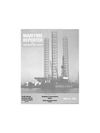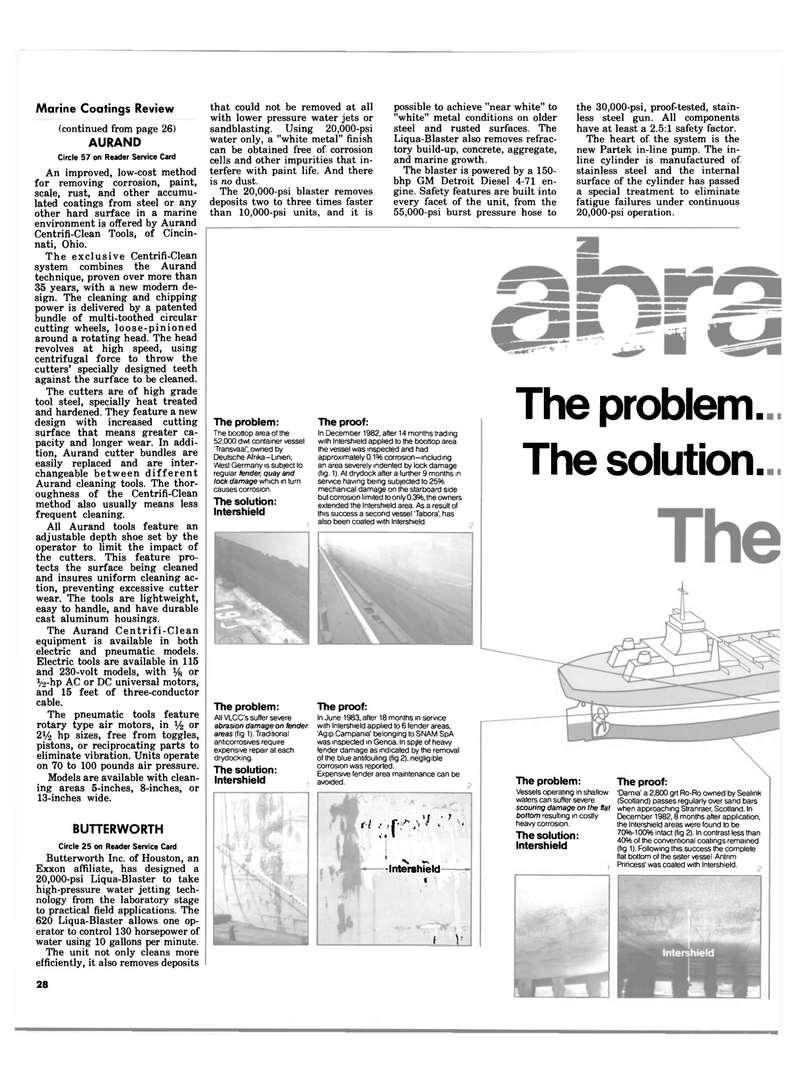
Page 26: of Maritime Reporter Magazine (May 1984)
Read this page in Pdf, Flash or Html5 edition of May 1984 Maritime Reporter Magazine
Marine Coatings Review (continued from page 26)
AURAND
Circle 57 on Reader Service Card
An improved, low-cost method for removing corrosion, paint, scale, rust, and other accumu- lated coatings from steel or any other hard surface in a marine environment is offered by Aurand
Centrifi-Clean Tools, of Cincin- nati, Ohio.
The exclusive Centrifi-Clean system combines the Aurand technique, proven over more than 35 years, with a new modern de- sign. The cleaning and chipping power is delivered by a patented bundle of multi-toothed circular cutting wheels, loose-pinioned around a rotating head. The head revolves at high speed, using centrifugal force to throw the cutters' specially designed teeth against the surface to be cleaned.
The cutters are of high grade tool steel, specially heat treated and hardened. They feature a new design with increased cutting surface that means greater ca- pacity and longer wear. In addi- tion, Aurand cutter bundles are easily replaced and are inter- changeable between different
Aurand cleaning tools. The thor- oughness of the Centrifi-Clean method also usually means less frequent cleaning.
All Aurand tools feature an adjustable depth shoe set by the operator to limit the impact of the cutters. This feature pro- tects the surface being cleaned and insures uniform cleaning ac- tion, preventing excessive cutter wear. The tools are lightweight, easy to handle, and have durable cast aluminum housings.
The Aurand Centrifi-Clean equipment is available in both electric and pneumatic models.
Electric tools are available in 115 and 230-volt models, with y8 or x/2-hp AC or DC universal motors, and 15 feet of three-conductor cable.
The pneumatic tools feature rotary type air motors, in y2 or 2i/2 hp sizes, free from toggles, pistons, or reciprocating parts to eliminate vibration. Units operate on 70 to 100 pounds air pressure.
Models are available with clean- ing areas 5-inches, 8-inches, or 13-inches wide.
BUTTERWORTH
Circle 25 on Reader Service Card
Butterworth Inc. of Houston, an
Exxon affiliate, has designed a 20,000-psi Liqua-Blaster to take high-pressure water jetting tech- nology from the laboratory stage to practical field applications. The 620 Liqua-Blaster allows one op- erator to control 130 horsepower of water using 10 gallons per minute.
The unit not only cleans more efficiently, it also removes deposits 28 that could not be removed at all with lower pressure water jets or sandblasting. Using 20,000-psi water only, a "white metal" finish can be obtained free of corrosion cells and other impurities that in- terfere with paint life. And there is no dust.
The 20,000-psi blaster removes deposits two to three times faster than 10,000-psi units, and it is possible to achieve "near white" to "white" metal conditions on older steel and rusted surfaces. The
Liqua-Blaster also removes refrac- tory build-up, concrete, aggregate, and marine growth.
The blaster is powered by a 150- bhp GM Detroit Diesel 4-71 en- gine. Safety features are built into every facet of the unit, from the 55,000-psi burst pressure hose to the 30,000-psi, proof-tested, stain- less steel gun. All components have at least a 2.5:1 safety factor.
The heart of the system is the new Partek in-line pump. The in- line cylinder is manufactured of stainless steel and the internal surface of the cylinder has passed a special treatment to eliminate fatigue failures under continuous 20,000-psi operation.
The problem:
The boottop area of the 52,000 dwt container vessel 'Transvaal', owned by
Deutsche Afrika—Linien,
West Germany is subject to regular fender, quay and lock damage which in turn causes corrosion.
The solution:
Intershield
The proof:
In December 1982, after 14 months trading with Intershield applied to the boottop area the vessel was inspected and had approximately 0.1% corrosion-including an area severely indented by lock damage (fig. 1). At drydock after a further 9 months in service having being subjected to 25% mechanical damage on the starboard side but corrosion limited to only 0.3%, the owners extended the Intershield area. As a result of this success a second vessel 'Tabora', has also been coated with Intershield.
The problem.
The solution.
The problem:
All VLCC's suffer severe abrasion damage on fender areas (fig 1). Traditional anticorrosives require expensive repair at each drydocking.
The solution:
Intershield i l | *•} i | ' '
The proof:
In June 1983, after 18 months in service with Intershield applied to 6 fender areas, 'Agip Campania' belonging to SNAM SpA was inspected in Genoa. In spite of heavy fender damage as indicated by the removal of the blue antifouling (fig 2), negligible corrosion was reported.
Expensive fender area maintenance can be avoided. ,7 ' » ' V w.. -Intershield « j Li
The problem:
Vessels operating in shallow waters can suffer severe scouring damage on the flat bottom resulting in costly heavy corrosion.
The solution:
Intershield
The proof: 'Darnia' a 2,800 grt Ro-Ro owned by Sealink (Scotland) passes regularly over sand bars when approaching Stranraer, Scotland. In
December 1982,8 months after application, the Intershield areas were found to be 70%-100% intact (fig 2). In contrast less than 40% of the conventional coatings remained (fig 1). Following this success the complete flat bottom of the sister vessel Antrim
Princess' was coated with Intershield.

 25
25

 27
27
